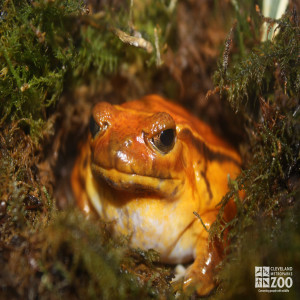Sambava Tomato Frog
[Dyscophus guineti]

The Sambava Tomato Frog is a medium-sized frog, with females about 2 inches long and males smaller. There are two dorsolateral folds on the smooth back. The male is yellowish whereas the female is red-orange with small black spots. The underside is uniformly yellowish, sometimes with black spots on the throat. There is a wide, dark brown line from the eye back to the forelimb. The forefeet are not webbed, and the rear leg webbing is variable. Juveniles are yellow on the back and dark on the flanks.
Location: The Lower RainForest
Share:
Range
The range of the Sambava Tomato Frog is Madagascar.
Habitat
The Sambava Tomato Frog inhabits forest leaf litter near swamps, shallow pools or water-filled ditches.
Conservation Status
Least ConcernPrimary Threats
Human-Wildlife CoexistenceGestation
Incubation: Sambava Tree Frog eggs hatch after about 36 hours; tadpoles take about 2 months for development.
Litter
Clutch size: about 1,000 small black and white eggs, deposited on surface of water
Behavior
Sambava Tree Frogs are nocturnal, being active in the evening and at night. This is a burrowing frog, spending most of its time half-hidden in underbrush waiting for food, or protecting itself from predators. The characteristic calls of this species can be heard at evening and night and sometimes during the day from swamps and pools after a heavy rain. They can inflate themselves as a defense against predation. The whitish skin secretions can produce allergic reactions in humans.
Reproduction
Sambava Tree Frog males mount the females for sperm transfer. Breeding is accomplished in stagnant or very slow-moving water. The tadpoles are transparent filter feeders that float horizontally in mid-water.
Wild Diet
Insects, worms, larvae
Zoo Diet
Insectivorous diet, mealworms
